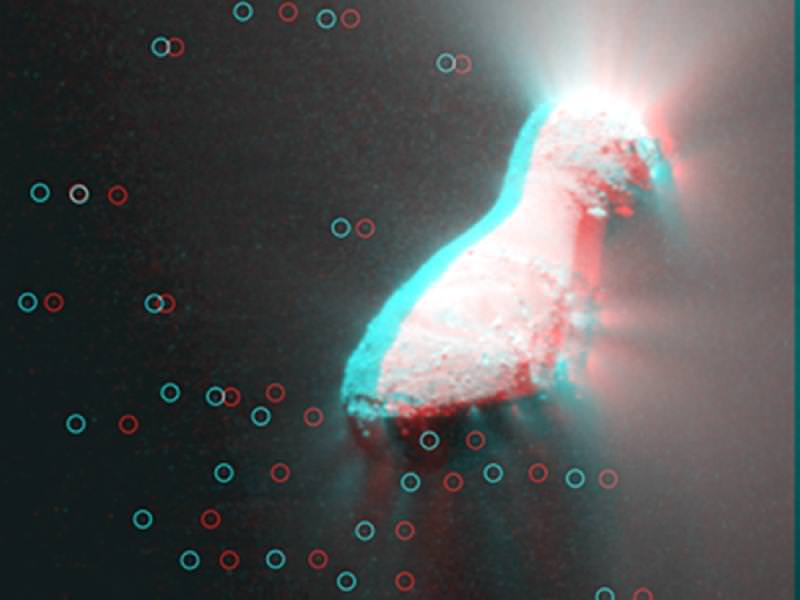[/caption]
As Jessica Sunshine said, Comet Hartley 2 might be the smallest of the five comets that our spacecraft have visited, but no doubt it is the most interesting, and for its size, the most active. Sunshine is the EPOXI mission deputy principal investigator, and she and her team have had the chance to analyze images from the Nov. 4 flyby of the comet. Closeup views yielded some big surprises: Hartley 2 is throwing snowballs.
"When we first saw all the specks surrounding the nucleus, our mouths dropped," said Pete Schultz, EPOXI mission co-investigator at Brown University. "Stereo images reveal there are snowballs in front and behind the nucleus, making it look like a scene in one of those crystal snow globes."
Estimates of the size of the largest particles ranges from a golf ball to a basketball.
Another surprise, which was noted almost immediately from the flyby images, were that the very active jets on the comet were powered by carbon dioxide. "This is the first time we've ever seen individual chunks of ice in the cloud around a comet or jets definitively powered by carbon dioxide gas," said Michael A'Hearn, principal investigator for the spacecraft. "We looked for, but didn't see, such ice particles around comet Tempel 1," the comet that the Deep Impact spacecraft flew by in 2005.
Here are highlights from the press conference last week, along with some of the fantastic imagery of Comet Hartley 2.
[caption id="attachment_79623" align="aligncenter" width="580" caption="Hartley 2 CO2 jet up close. Credit: NASA/JPL-Caltech/UMD/Brown "]
[/caption]
[caption id="attachment_79624" align="aligncenter" width="580" caption="Comet Hartley 2 can be seen in glorious detail in this image from NASA's EPOXI mission. It was taken as the spacecraft flew by around 6:59 a.m. PDT (9:59 a.m. EDT), from a distance of about 700 kilometers (435 miles). The comet's nucleus, or main body, is approximately 2 kilometers (1.2 miles) long and .4 kilometers (.25 miles) at the 'neck' or most narrow portion. Jets can be seen streaming out of the nucleus. Image credit: NASA/JPL-Caltech/UMD"]
[/caption]
[caption id="attachment_79625" align="aligncenter" width="580" caption="This image from the High-Resolution Instrument on NASA's EPOXI mission spacecraft shows part of the nucleus of comet Hartley 2. The sun is illuminating the nucleus from the right. A distinct cloud of individual particles is visible. This image was obtained on Nov. 4, 2010, the day the EPOXI mission spacecraft made its closest approach to the comet. Image Credit: NASA/JPL-Caltech/UMD "]
[/caption]
[caption id="attachment_79626" align="aligncenter" width="580" caption="Infrared scans of comet Hartley 2 by NASA's EPOXI mission spacecraft show carbon dioxide, dust, and ice being distributed in a similar way and emanating from apparently the same locations on the nucleus. Water vapor, however, has a different distribution implying a different source region and process. Image Credit: NASA/JPL-Caltech/UMD"]
[/caption]
[caption id="attachment_79628" align="aligncenter" width="580" caption="This zoomed-in image from the High-Resolution Instrument on NASA's EPOXI mission spacecraft shows the particles swirling in a 'snow storm' around the nucleus of comet Hartley 2. Scientists estimate the size of the largest particles ranges from a golf ball to a basketball. They have determined these are icy particles rather than dust. The particles are believed to be very porous and fluffy. Image Credit: NASA/JPL-Caltech/UMD"]
[/caption]
[caption id="attachment_79627" align="aligncenter" width="580" caption="The motion of some icy particles in the cloud around Hartley 2, as seen by NASA's EPOXI mission spacecraft. A star moving through the background is marked with red and moves in a particular direction and with a particular speed, while the icy particles move in random directions. The icy particles are marked in green, blue and light blue. Image Credit: NASA/JPL-Caltech/UMD/Brown "]
[/caption]
[caption id="attachment_79629" align="aligncenter" width="580" caption="This image shows the nuclei of comets Tempel 1 and Hartley 2, as imaged by NASA's Deep Impact spacecraft, which continued as an extended mission known as EPOXI. Tempel 1 is five times larger than Hartley 2. Visible jets are easily seen in images of Hartley 2, but required extensive processing to be seen in images of Tempel 1. Tempel 1 is 7.6 kilometers (4.7 miles) in the longest dimension. Hartley 2 is 2.2 km (1.4 miles) long. The Tempel 1 image was built up from more than 25 images captured by the impactor targeting sensor on July 4, 2005. The Hartley 2 image was obtained by the Medium- Resolution Imager on Nov. 4, 2010. "]
[/caption]
 Universe Today
Universe Today
